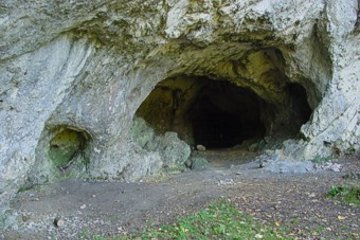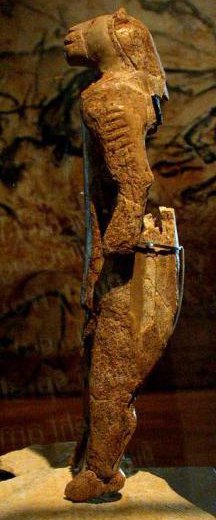The Vogelherd Lion
It isn't all that long ago that "artist's impressions" in the National Geographic were depicting our remote ancestors as black hairy creatures with simian faces, their paws clutching the most primitive of stone tools, and wearing expressions of bestial greed as they contemplated the freshly slaughtered carcase of a mammoth or some other delicacy of the Ice Age.

| |
| The entrance to the Vogelherd Cave in Germany |
There are many things wrong with this picture, but I would just like to draw your attention to one of them. The artist respnsible for the "impression" failed to put in the foreground his artistic counterpart delicately carving the tusk of the fallen mammoth into a piece of artwork that can stand comparison with the best that moderns can produce.
Of course, we have long known that our predecessors were capable of remarkable art work. There are the famous cave paintings of Lascaux and other places to show just how skilled and confident these supposedly primitive hunters were. In fact, those on our tour of Greece and Italy in 2007 saw examples of this in the Palermo Museum, were some incised cave art was on display. The most lively figures were cut into the rock without a single false line in a manner that leaves me breathless with admiration.

| |
| The Vogelherd Lion, which may be intended to represent a human wearing a lion mask, or may be a humanised lion. |
More recently archaeologists in Germany have been putting together the tiny fragments of ivory they recovered when excavating the "Bird Flock Cave" - Vogelherd Cave - located in the Lone Valley in southern Germany.
Dated to the Aurignacien period, these objects include the earlist known musical instruments - flutes from the Geissenklosterle Cave near Blaubeuren (between Muich and Stuttgart). The Bird Flock CaVe, however, produced remarkable ivory statues of animals and, most impressive of all, two "lion men". These statues, which are nearly 10" high - show a deftness and surety of touch, as well as a high artistic imagination, in depicting a lion standing on its hind legs with its front paws tucked into what would be its pockets if it were wearing trousers.
You can see the lion for yourself by visiting the Ice Age Art site and remember, as you admire its exquisitely carved face, that this was produced by someone supposedly only a step or two removed from an ape.
Personally, I think that the National Geographic and its artists have mistaken primitive technology for primitive nature. It seems to me that the people of the Aurignacien were as intelligent and dextrous as we are; they had not yet "invented" metal tools - or perhaps they saw no need for them, given their skill in producing stone ones - but apart from that they could probably live next door to anyone of us without exciting comment.
p>Apart, of course, from the fact that their artistic skill is far in excess of mine. Perhaps I could trade lessons in how to retouch a photograph in Photoshop for hints and tips on how to carve a mammoth tusk. Or, of course, in how to get the mammoth in the first place!




